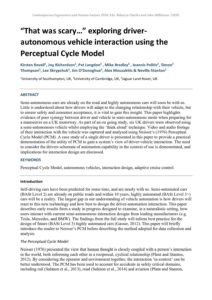| Document | Author Kirsten Revell, Joy Richardson, Pat Langdon, Mike Bradley , Ioannis Politis, Simon Thompson, Lee Skrypchuk, Jim O’Donoghue, Alex Mouzakitis & Neville Stanton |
| Abstract Semi-autonomous cars are already on the road and highly autonomous cars will soon be with us. Little is understood about how drivers will adapt to the changing relationship with their vehicle, but to ensure safety and consumer acceptance, it is vital to gain this insight. This paper highlights evidence of poor synergy between driver and vehicle in semi-autonomous mode when preparing for a manoeuvre on a UK motorway. As part of an on going study, six UK drivers were observed using a semi-autonomous vehicle whilst employing the ‘think aloud’ technique. Video and audio footage of their interaction with the vehicle was captured and analysed using Neisser’s (1976) Perceptual Cycle Model (PCM). A case study of a single driver is presented in this paper to provide a practical demonstration of the utility of PCM to gain a system’s view of driver-vehicle interaction. The need to consider the drivers schemata of automation capability in the context of use is demonstrated, and implications for interaction design are discussed. |

